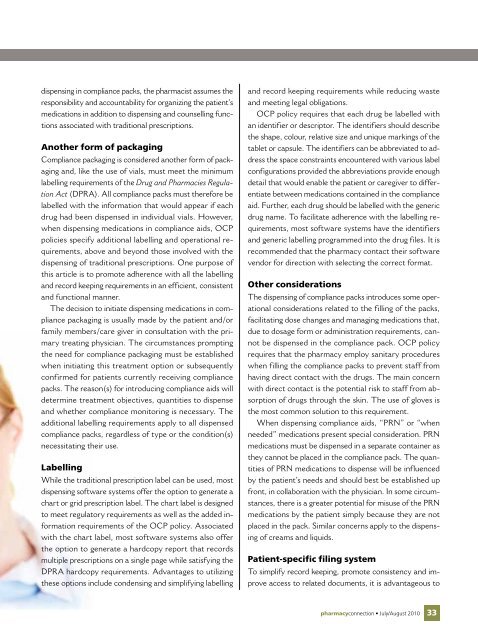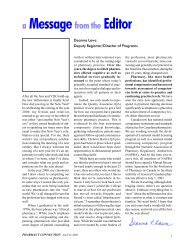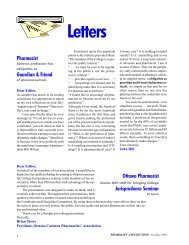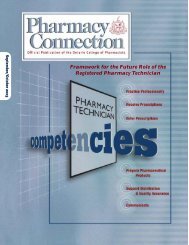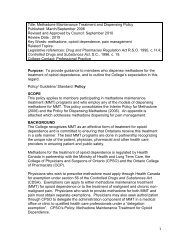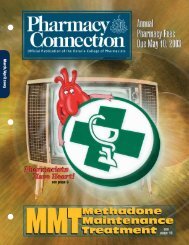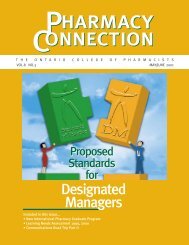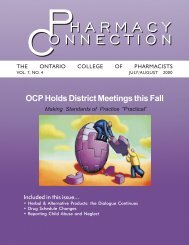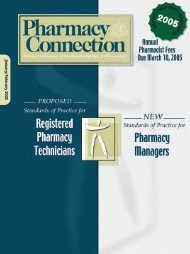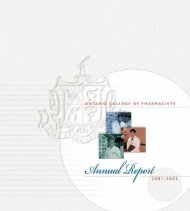Standards of Practice for Pharmacists Anti-infective Guidelines ...
Standards of Practice for Pharmacists Anti-infective Guidelines ...
Standards of Practice for Pharmacists Anti-infective Guidelines ...
You also want an ePaper? Increase the reach of your titles
YUMPU automatically turns print PDFs into web optimized ePapers that Google loves.
dispensing in compliance packs, the pharmacist assumes the<br />
responsibility and accountability <strong>for</strong> organizing the patient’s<br />
medications in addition to dispensing and counselling functions<br />
associated with traditional prescriptions.<br />
Another <strong>for</strong>m <strong>of</strong> packaging<br />
Compliance packaging is considered another <strong>for</strong>m <strong>of</strong> packaging<br />
and, like the use <strong>of</strong> vials, must meet the minimum<br />
labelling requirements <strong>of</strong> the Drug and Pharmacies Regulation<br />
Act (DPRA). All compliance packs must there<strong>for</strong>e be<br />
labelled with the in<strong>for</strong>mation that would appear if each<br />
drug had been dispensed in individual vials. However,<br />
when dispensing medications in compliance aids, OCP<br />
policies specify additional labelling and operational requirements,<br />
above and beyond those involved with the<br />
dispensing <strong>of</strong> traditional prescriptions. One purpose <strong>of</strong><br />
this article is to promote adherence with all the labelling<br />
and record keeping requirements in an efficient, consistent<br />
and functional manner.<br />
The decision to initiate dispensing medications in compliance<br />
packaging is usually made by the patient and/or<br />
family members/care giver in consultation with the primary<br />
treating physician. The circumstances prompting<br />
the need <strong>for</strong> compliance packaging must be established<br />
when initiating this treatment option or subsequently<br />
confirmed <strong>for</strong> patients currently receiving compliance<br />
packs. The reason(s) <strong>for</strong> introducing compliance aids will<br />
determine treatment objectives, quantities to dispense<br />
and whether compliance monitoring is necessary. The<br />
additional labelling requirements apply to all dispensed<br />
compliance packs, regardless <strong>of</strong> type or the condition(s)<br />
necessitating their use.<br />
Labelling<br />
While the traditional prescription label can be used, most<br />
dispensing s<strong>of</strong>tware systems <strong>of</strong>fer the option to generate a<br />
chart or grid prescription label. The chart label is designed<br />
to meet regulatory requirements as well as the added in<strong>for</strong>mation<br />
requirements <strong>of</strong> the OCP policy. Associated<br />
with the chart label, most s<strong>of</strong>tware systems also <strong>of</strong>fer<br />
the option to generate a hardcopy report that records<br />
multiple prescriptions on a single page while satisfying the<br />
DPRA hardcopy requirements. Advantages to utilizing<br />
these options include condensing and simplifying labelling<br />
and record keeping requirements while reducing waste<br />
and meeting legal obligations.<br />
OCP policy requires that each drug be labelled with<br />
an identifier or descriptor. The identifiers should describe<br />
the shape, colour, relative size and unique markings <strong>of</strong> the<br />
tablet or capsule. The identifiers can be abbreviated to address<br />
the space constraints encountered with various label<br />
configurations provided the abbreviations provide enough<br />
detail that would enable the patient or caregiver to differentiate<br />
between medications contained in the compliance<br />
aid. Further, each drug should be labelled with the generic<br />
drug name. To facilitate adherence with the labelling requirements,<br />
most s<strong>of</strong>tware systems have the identifiers<br />
and generic labelling programmed into the drug files. It is<br />
recommended that the pharmacy contact their s<strong>of</strong>tware<br />
vendor <strong>for</strong> direction with selecting the correct <strong>for</strong>mat.<br />
Other considerations<br />
The dispensing <strong>of</strong> compliance packs introduces some operational<br />
considerations related to the filling <strong>of</strong> the packs,<br />
facilitating dose changes and managing medications that,<br />
due to dosage <strong>for</strong>m or administration requirements, cannot<br />
be dispensed in the compliance pack. OCP policy<br />
requires that the pharmacy employ sanitary procedures<br />
when filling the compliance packs to prevent staff from<br />
having direct contact with the drugs. The main concern<br />
with direct contact is the potential risk to staff from absorption<br />
<strong>of</strong> drugs through the skin. The use <strong>of</strong> gloves is<br />
the most common solution to this requirement.<br />
When dispensing compliance aids, “PRN” or “when<br />
needed” medications present special consideration. PRN<br />
medications must be dispensed in a separate container as<br />
they cannot be placed in the compliance pack. The quantities<br />
<strong>of</strong> PRN medications to dispense will be influenced<br />
by the patient’s needs and should best be established up<br />
front, in collaboration with the physician. In some circumstances,<br />
there is a greater potential <strong>for</strong> misuse <strong>of</strong> the PRN<br />
medications by the patient simply because they are not<br />
placed in the pack. Similar concerns apply to the dispensing<br />
<strong>of</strong> creams and liquids.<br />
Patient-specific filing system<br />
To simplify record keeping, promote consistency and improve<br />
access to related documents, it is advantageous to<br />
pharmacyconnection • July/August 2010<br />
33


